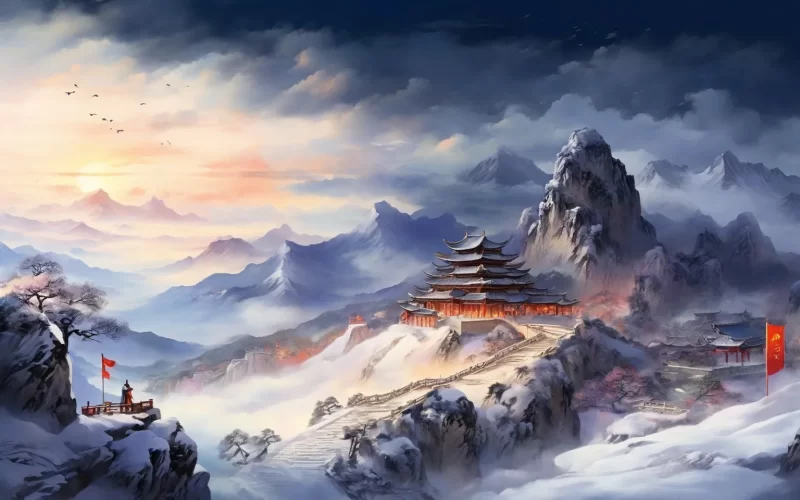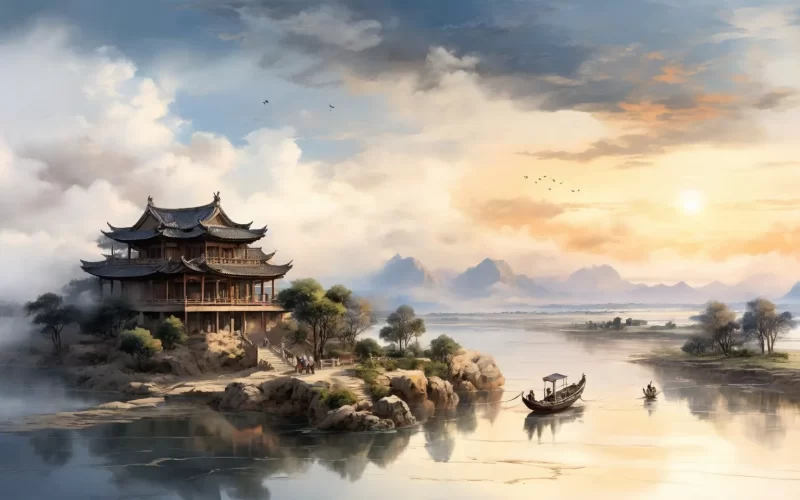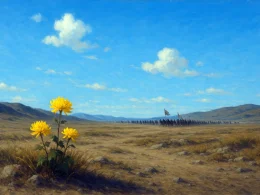See how Zhongnan Mountain soars
With its white top over floating clouds --
And a warm sky opening at the snow-line
While the town in the valley grows colder and colder.
Original Poem
「终南望余雪」
祖咏
终南阴岭秀,积雪浮云端。
林表明霁色,城中增暮寒。
Interpretation
This occasional poem was likely composed by Zu Yong during his early years in Chang'an, either while taking imperial examinations or serving in office. Located south of the capital, Mount Zhongnan had long been revered as the "Imperial Mountain," inspiring numerous literary tributes. After winter snowfall, its majestic scenery moved the poet to craft this fresh-imagined, ethereal verse upon viewing the distant snow-clad peaks.
First Couplet: "终南阴岭秀,积雪浮云端。"
Zhōng nán yīn lǐng xiù, jī xuě fú yún duān.
The northern slopes of Zhongnan glow in splendor—
Their accumulated snow floats above cloud-wreathed heights.
The opening depicts the mountain vista from Chang'an. "Northern slopes" (阴岭) specifically reference the shaded side, with "glow in splendor" (秀) capturing its elegant beauty. The character "float" (浮) brilliantly animates the static snowscape, suggesting sunlit peaks transcendent above clouds—an almost celestial vision.
Second Couplet: "林表明霁色,城中增暮寒。"
Lín biǎo míng jì sè, chéng zhōng zēng mù hán.
Tree lines gleam with post-storm clarity,
Yet twilight deepens the capital's chill.
"Post-storm clarity" (霁色) illuminates the forest canopy, enhancing the mountain's divine aura. The shift to "twilight's deepening chill" in the city connects the distant spectacle with the poet's immediate sensory experience, merging external grandeur with intimate atmosphere in perfect artistic synthesis.
Holistic Appreciation
Centered on the act of gazing, the poem unfolds as the poet, standing in Chang'an, looks afar at the snow-capped Zhongnan Mountains, experiencing both the visual impact and the palpable shift in temperature brought by this natural spectacle. In just four lines, it captures the fusion of objective scenery and subjective sensation—moving from mountain to forest, distance to proximity, sight to mind—with exquisite structure and layered clarity. Verbs like "float," "gleam," and "intensify" inject quiet dynamism into the stillness, revealing light within the cold. With minimal words, it achieves a realm of lofty serenity.
Artistic Merits
- Precision in Motion: Words like "float" and "intensify" lend vitality to the snowy landscape.
- Delicate Structure, Blending Real and Ethereal: The first couplet depicts the mountains; the second introduces sunlight contrasted against the cold, crafting an evocative atmosphere.
- Scene and Sentiment Intertwined: Through Zhongnan's snowscape, the poet conveys post-storm chill, reflecting acute perception of nature and an inner clarity.
Insights
This poem embodies the ancient tradition of channeling emotion through nature, urging us in our hurried lives to pause and observe the subtle beauty of seasonal shifts. Its concise yet expansive chilliness also showcases classical poetry’s unique power—"more with less"—where brevity conjures boundless resonance.
Poem translator
Kiang Kanghu
About the poet
Zu Yong (祖咏, 699 - 746?), a native of Luoyang, Henan, was a High Tang dynasty landscape poet who attained the jinshi degree in 724. Associated with Wang Wei and Chu Guangxi, he later retreated to Rufen as a recluse. Though few works survive, his five-character verse—spare yet classically elevated—established him as a key forerunner of High Tang nature poetry.











